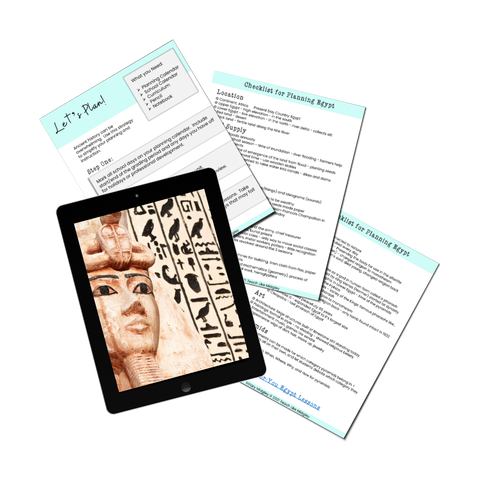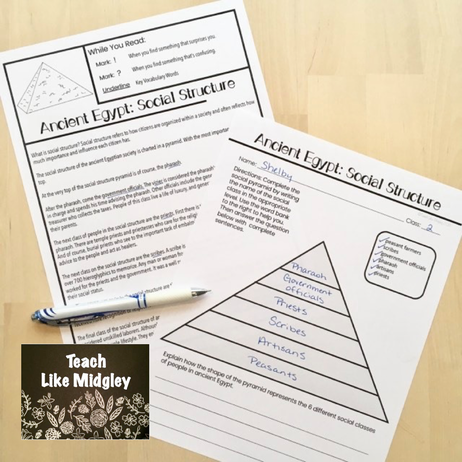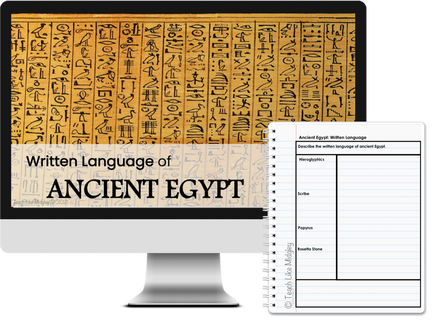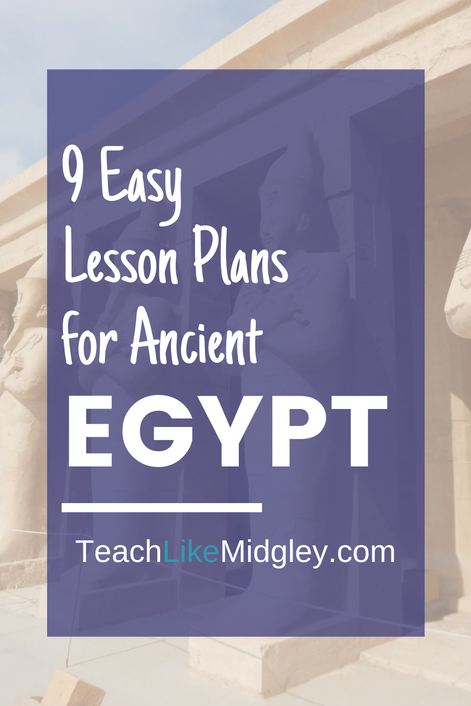9 Easy Lesson Plans for Ancient Egypt
Ancient Egypt lesson plans can easily become overwhelming. It’s easy to get caught up in the excitement of ancient Egypt. Many of us, young or old, get caught in awe of the beauty and impressive feats of the ancient Egyptians.
When it comes to ancient Egypt lesson plans, it’s easy to gravitate to student projects like drawing and constructing pyramids, tombs, and death masks.
While these types of activities are fun and engaging, it’s also important to make sure we are focused on the significance of these topics and covering the essentials of ancient Egyptian history.
When I first started teaching ancient history, I was clueless. I had no guidance and no curriculum to help guide me. I also had no background in teaching history. You can read more about my story, here: Defining Your Identity As A Teacher
There was so much information, and I had no idea where to begin. I didn’t have the faintest idea what was important and what I needed to focus on with my lesson plans.
It amazes me how many teachers are in the same boat that I was in, oh so many years ago. I also know there is more pressure today to focus on projects and make lessons entertaining. Many questions I see come across various social media groups, usually say something like, does anyone have a fun lesson for teaching ____? Usually that question is focused on a monument or famous topic of the society. And I wonder about the focus of the lesson.
When it comes to ancient Egypt lesson plans, it’s easy to gravitate to student projects like drawing and constructing pyramids, tombs, and death masks.
While these types of activities are fun and engaging, it’s also important to make sure we are focused on the significance of these topics and covering the essentials of ancient Egyptian history.
When I first started teaching ancient history, I was clueless. I had no guidance and no curriculum to help guide me. I also had no background in teaching history. You can read more about my story, here: Defining Your Identity As A Teacher
There was so much information, and I had no idea where to begin. I didn’t have the faintest idea what was important and what I needed to focus on with my lesson plans.
It amazes me how many teachers are in the same boat that I was in, oh so many years ago. I also know there is more pressure today to focus on projects and make lessons entertaining. Many questions I see come across various social media groups, usually say something like, does anyone have a fun lesson for teaching ____? Usually that question is focused on a monument or famous topic of the society. And I wonder about the focus of the lesson.
My mission for Teach Like Midgley has always been to provide teachers with support and guidance in a way that I never experienced as a teacher. The profession is already too stressful, and adding unnecessary confusion only adds to it. My experience has taught me that you can organize, simplify, and streamline your instruction, yet still be engaging, supportive, and challenging.
This post will share with you nine easy ancient Egypt lesson plans that will allow you to teach with confidence.
Teaching With Structure
Organizing your content is the best thing you can do – for yourself and for your students. When I started teaching ancient civilizations with a seven part structure, I saw an immediate difference in my classroom.
My lesson plans were easier to write, my units flowed and made sense, and my students were able to comprehend concepts and see connections like never before.
Ancient Egypt fits into this structure easier than almost any other civilization. Which allows students to gain a strong understanding of how the structure works. You will notice that some aspects can fit into more than one of the seven parts. This is perfectly fine – your focus should be on helping your students justify why it belongs in the part you choose to categorize it in.
The first week of the school year is focused on teaching procedures and essential skills like maps and timelines. Our first unit is on prehistory, then ancient Mesopotamia, and then ancient Egypt.
If you’d like to see how I teach prehistory, then check out this post: 5 Easy Lesson Plans for Teaching Prehistory
And if you want to see how I introduce the seven part structure to my students with my ancient Mesopotamia unit, then this post is a must read: How to Teach Ancient Civilizations the Easy Way
My lesson plans were easier to write, my units flowed and made sense, and my students were able to comprehend concepts and see connections like never before.
Ancient Egypt fits into this structure easier than almost any other civilization. Which allows students to gain a strong understanding of how the structure works. You will notice that some aspects can fit into more than one of the seven parts. This is perfectly fine – your focus should be on helping your students justify why it belongs in the part you choose to categorize it in.
The first week of the school year is focused on teaching procedures and essential skills like maps and timelines. Our first unit is on prehistory, then ancient Mesopotamia, and then ancient Egypt.
If you’d like to see how I teach prehistory, then check out this post: 5 Easy Lesson Plans for Teaching Prehistory
And if you want to see how I introduce the seven part structure to my students with my ancient Mesopotamia unit, then this post is a must read: How to Teach Ancient Civilizations the Easy Way
Lesson #1 Get the Wiggles Out
There aren’t too many students who have come through my classroom and have never heard of ancient Egypt. In fact, there are often several who are super pumped for the unit and eager to share what they know.
Every year my very first lesson on ancient Egypt includes a modified version of the KWL chart.
I allow students to share what they think they know about ancient Egypt. This gives me lots of insight as to their level of knowledge and what misconceptions they may have. Then we list out what students want to know about ancient Egypt. This shows me their interests and what pieces I should be sure to include in my lessons.
Lesson #2 Location & Geography
Every unit begins with location. I don’t consider location to be part of the seven part structure. Just because there’s a permanent settlement, doesn’t make it a civilization. We know from our prehistory unit that choosing a good location is crucial to establishing a stable food supply.
We also know that geography plays an important part in protection and defensive positioning in case of attack. It can also heavily affect travel, which influences government and trade.
Since we are talking about someplace halfway around the world, I also make sure to help students identify continent, present-day country, and geographical features that influenced the culture.
When teaching about ancient Egypt location and geography, my focus is on...
+ Northern Africa
+ Upper Egypt
+ Lower Egypt
+ Nile River
+ Nile Gifts
+ Nile Dangers
We also know that geography plays an important part in protection and defensive positioning in case of attack. It can also heavily affect travel, which influences government and trade.
Since we are talking about someplace halfway around the world, I also make sure to help students identify continent, present-day country, and geographical features that influenced the culture.
When teaching about ancient Egypt location and geography, my focus is on...
+ Northern Africa
+ Upper Egypt
+ Lower Egypt
+ Nile River
+ Nile Gifts
+ Nile Dangers
Lesson #3 Stable Food Supply
No civilization can exist without a stable food supply for its people. Too often this concept is skipped over and not given enough emphasis. Even since the beginning, civilizations have given little respect to farmers even though they are the foundation of life itself.
Farming is an easy transition from the previous lesson, since the location and geography have a heavy influence on the ability to produce food.
When teaching about ancient Egypt food supply, my focus is on...
+ The 3 seasons
+ Crops
+ Flax
+ Papyrus
+ Irrigation
Farming is an easy transition from the previous lesson, since the location and geography have a heavy influence on the ability to produce food.
When teaching about ancient Egypt food supply, my focus is on...
+ The 3 seasons
+ Crops
+ Flax
+ Papyrus
+ Irrigation
Lesson #4 Government
Government is often one of the largest and more complex parts of the seven part structure. Not only do you need to focus on the type of government used and how it works, but you are also looking at the different periods of time, military conquests, and battles fought.
When teaching about ancient Egypt government, my focus is on...
+ Theocracy
+ Uniting Egypt
+ Old Kingdom
+ Middle Kingdom
+ New Kingdom
+ Famous Pharaohs
When teaching about ancient Egypt government, my focus is on...
+ Theocracy
+ Uniting Egypt
+ Old Kingdom
+ Middle Kingdom
+ New Kingdom
+ Famous Pharaohs
Lesson #5 Religion
Religion is an easy transition from the previous lesson, since in ancient times government and religion were heavily connected.
Some teachers get nervous teaching about religion, especially if they are teaching in a public school. But the reality is that religion has had a heavy impact on history. We can’t ignore it.
When teaching about religion, focus on the type of religion, and why it began. Sometimes I touch on how it began, but I try to stay away from origin stories. In my experience, this is where parents start to complain or take issue. Then focus on how the religious beliefs of the people influenced their daily lives and culture.
When teaching about ancient Egypt religion, my focus is on...
+ Polytheism
+ Sun God, Ra
+ Afterlife and Mummification
+ Pyramids
+ Amenhotep IV
+ Tutankhamen
Lesson #6 Social Structure
Understanding how different levels of society work can be a bit tricky. Which is why the next lesson is about social structure. Daily life in ancient societies was heavily influenced by the social class one was born into.
Ancient Egypt make understanding the concept of social structure much easier than other civilizations. There were six obvious social classes.
When teaching about ancient Egypt social structure, my focus is on...
+ Pharaoh
+ Government Officials
+ Priests
+ Scribes
+ Artisans
+ Peasants/Farmers
Lesson #7 Written Language
Writing is arguably one of man’s greatest accomplishments. Thanks to ancient writings, we have been able to learn a lot about ancient life and history.
This is especially evident when we study ancient Egypt. For a time, the ancient Egyptian language was lost to us. Thanks to its rediscovery, we have learned a great deal about the ancient Egyptians.
Crafting a language, writing tools and materials, was no small feat for ancient people. It originally derived from need, most often to track trade and laws.
When teaching ancient Egypt written language, my focus is on...
+ Hieroglyphics
+ Scribes
+ Papyrus
+ Rosetta Stone
This is especially evident when we study ancient Egypt. For a time, the ancient Egyptian language was lost to us. Thanks to its rediscovery, we have learned a great deal about the ancient Egyptians.
Crafting a language, writing tools and materials, was no small feat for ancient people. It originally derived from need, most often to track trade and laws.
When teaching ancient Egypt written language, my focus is on...
+ Hieroglyphics
+ Scribes
+ Papyrus
+ Rosetta Stone
Lessons #8 & #9 Accomplishments
Most civilizations have had a time in history where life was good and extra accomplishments could be made. Often referred to as the golden age, people were living good lives with their basic needs met.
During this time, people (of particular classes) had time to explore and create new things. The last two parts of the seven part structure are considered arts and technology.
Together they can be combined and referred to as the society’s accomplishments and achievements.
It’s important to define the term technology, since many kiddos today associate the term with electronics. But by definition, technology is a new way of doing something that is easier than before. New technologies often come in the way of new inventions or knowledge discoveries.
Similarly, the concept of arts is more than just painting. In fact, arts refers to anything done for entertainment purposes. While this includes painting, sculpting, and architectural style, it also includes music, games, theater, and even literature styles.
When teaching ancient Egypt technology, my focus is on...
+ Technology
+ Inventions
+ Discoveries
When teaching ancient Egypt arts, my focus is on...
+ Architecture
+ Paintings
+ Entertainment
+ Appearance
During this time, people (of particular classes) had time to explore and create new things. The last two parts of the seven part structure are considered arts and technology.
Together they can be combined and referred to as the society’s accomplishments and achievements.
It’s important to define the term technology, since many kiddos today associate the term with electronics. But by definition, technology is a new way of doing something that is easier than before. New technologies often come in the way of new inventions or knowledge discoveries.
Similarly, the concept of arts is more than just painting. In fact, arts refers to anything done for entertainment purposes. While this includes painting, sculpting, and architectural style, it also includes music, games, theater, and even literature styles.
When teaching ancient Egypt technology, my focus is on...
+ Technology
+ Inventions
+ Discoveries
When teaching ancient Egypt arts, my focus is on...
+ Architecture
+ Paintings
+ Entertainment
+ Appearance
Ready to Roll Materials...
It’s easy to get caught up in pyramids and mummies when you are teaching ancient Egypt. But as you can see, there are lots of other essential components to ancient Egyptian history.
If you focus on teaching these essential lessons, then you can take the extra time you have for your unit and dive into a project that goes more in depth on a topic that is of interest to your students.
Remember that organizing and simplifying your content does not mean that you are “dumbing it down” It just means that you helping your students comprehend complex concepts and teaching them how to break it down. In fact, when you organize and simplify your content, you will find that your students are able to gain a much better understanding and will be eager to learn more.
Often when students don’t like history class, it’s because they don’t understand what’s being taught. I’ve had many parents express how surprised they were because their child never enjoyed history before, but left my class loving it. I can tell you that this is not because I teach elaborate, entertaining lessons. It is because I teach with structure and remove the complication. My goal is that this blog post and my resources will help you do the same.
Now that you know what to teach, you can get started right away. But if you are looking for a bit more guidance and some done-for-you materials, then check out my Ancient Egypt Lesson Sets. I have created a set of materials that go with each of these lessons so you can confidently deliver your essentials. Click here to check them out: Ancient Egypt Lesson Set Resources
If you focus on teaching these essential lessons, then you can take the extra time you have for your unit and dive into a project that goes more in depth on a topic that is of interest to your students.
Remember that organizing and simplifying your content does not mean that you are “dumbing it down” It just means that you helping your students comprehend complex concepts and teaching them how to break it down. In fact, when you organize and simplify your content, you will find that your students are able to gain a much better understanding and will be eager to learn more.
Often when students don’t like history class, it’s because they don’t understand what’s being taught. I’ve had many parents express how surprised they were because their child never enjoyed history before, but left my class loving it. I can tell you that this is not because I teach elaborate, entertaining lessons. It is because I teach with structure and remove the complication. My goal is that this blog post and my resources will help you do the same.
Now that you know what to teach, you can get started right away. But if you are looking for a bit more guidance and some done-for-you materials, then check out my Ancient Egypt Lesson Sets. I have created a set of materials that go with each of these lessons so you can confidently deliver your essentials. Click here to check them out: Ancient Egypt Lesson Set Resources
You May Also Like...
Let's Connect...

Welcome! I'm Hillary Midgley, a veteran 6th grade teacher.
I create educational materials and develop curriculum for other teachers. I specialize in teaching students how to learn through my Study Skills Curriculum. I have established fundamental classroom systems and structures for teachers to help them streamline their classroom. And my passion is teaching ancient history through engaging activities with foundations in academic skills. Here you will find resources on all of these topics and more. Learn more about me here.
|














